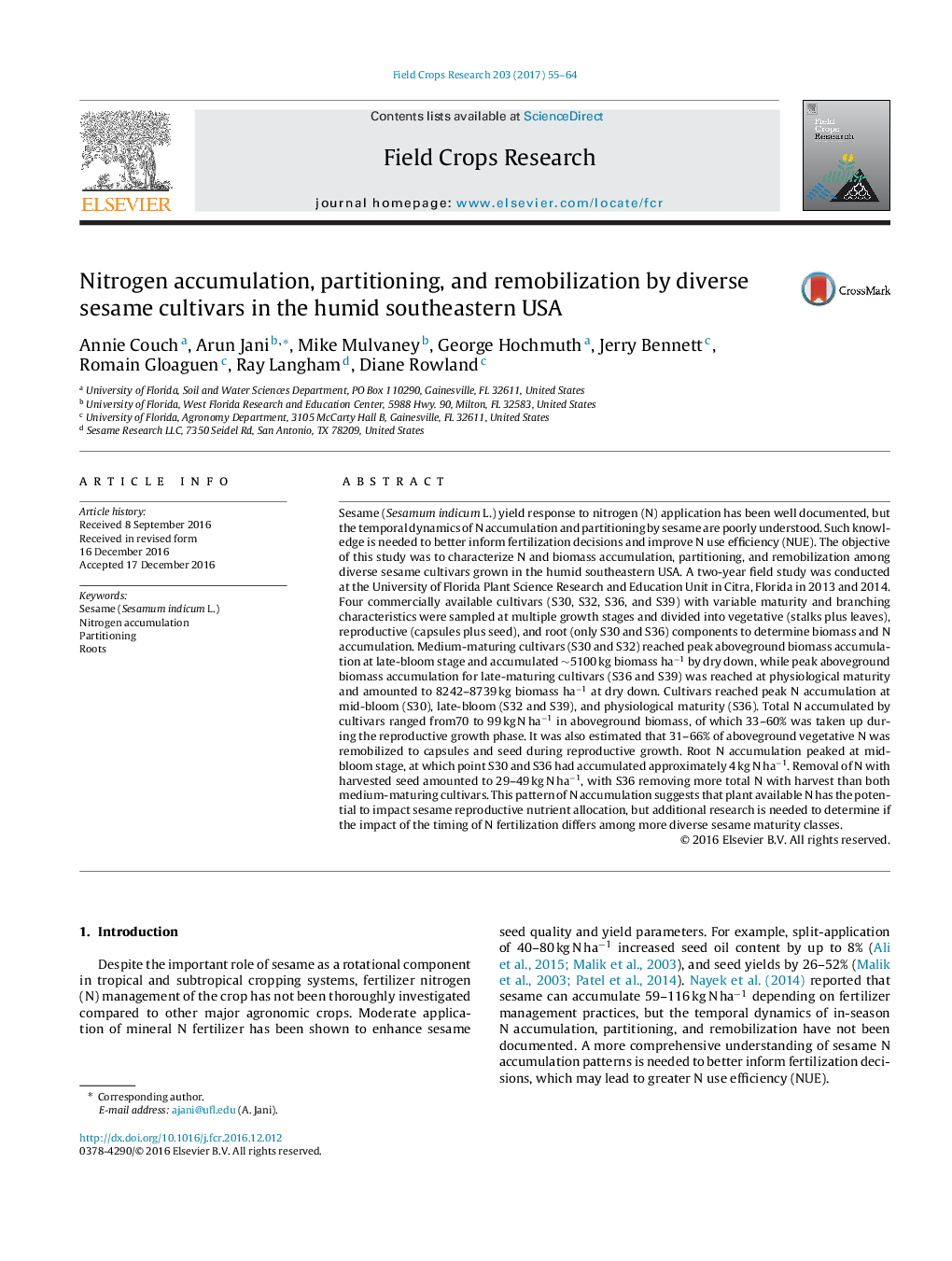| کد مقاله | کد نشریه | سال انتشار | مقاله انگلیسی | نسخه تمام متن |
|---|---|---|---|---|
| 5761465 | 1624660 | 2017 | 10 صفحه PDF | دانلود رایگان |
عنوان انگلیسی مقاله ISI
Nitrogen accumulation, partitioning, and remobilization by diverse sesame cultivars in the humid southeastern USA
ترجمه فارسی عنوان
تجمع نیتروژن، پراکندگی و بازسازی با ارقام مختلف کنجد در مرطوب جنوب شرقی ایالات متحده
دانلود مقاله + سفارش ترجمه
دانلود مقاله ISI انگلیسی
رایگان برای ایرانیان
موضوعات مرتبط
علوم زیستی و بیوفناوری
علوم کشاورزی و بیولوژیک
علوم زراعت و اصلاح نباتات
چکیده انگلیسی
Sesame (Sesamum indicum L.) yield response to nitrogen (N) application has been well documented, but the temporal dynamics of N accumulation and partitioning by sesame are poorly understood. Such knowledge is needed to better inform fertilization decisions and improve N use efficiency (NUE). The objective of this study was to characterize N and biomass accumulation, partitioning, and remobilization among diverse sesame cultivars grown in the humid southeastern USA. A two-year field study was conducted at the University of Florida Plant Science Research and Education Unit in Citra, Florida in 2013 and 2014. Four commercially available cultivars (S30, S32, S36, and S39) with variable maturity and branching characteristics were sampled at multiple growth stages and divided into vegetative (stalks plus leaves), reproductive (capsules plus seed), and root (only S30 and S36) components to determine biomass and N accumulation. Medium-maturing cultivars (S30 and S32) reached peak aboveground biomass accumulation at late-bloom stage and accumulated â¼5100 kg biomass haâ1 by dry down, while peak aboveground biomass accumulation for late-maturing cultivars (S36 and S39) was reached at physiological maturity and amounted to 8242-8739 kg biomass haâ1 at dry down. Cultivars reached peak N accumulation at mid-bloom (S30), late-bloom (S32 and S39), and physiological maturity (S36). Total N accumulated by cultivars ranged from70 to 99 kg N haâ1 in aboveground biomass, of which 33-60% was taken up during the reproductive growth phase. It was also estimated that 31-66% of aboveground vegetative N was remobilized to capsules and seed during reproductive growth. Root N accumulation peaked at mid-bloom stage, at which point S30 and S36 had accumulated approximately 4 kg N haâ1. Removal of N with harvested seed amounted to 29-49 kg N haâ1, with S36 removing more total N with harvest than both medium-maturing cultivars. This pattern of N accumulation suggests that plant available N has the potential to impact sesame reproductive nutrient allocation, but additional research is needed to determine if the impact of the timing of N fertilization differs among more diverse sesame maturity classes.
ناشر
Database: Elsevier - ScienceDirect (ساینس دایرکت)
Journal: Field Crops Research - Volume 203, 1 March 2017, Pages 55-64
Journal: Field Crops Research - Volume 203, 1 March 2017, Pages 55-64
نویسندگان
Annie Couch, Arun Jani, Mike Mulvaney, George Hochmuth, Jerry Bennett, Romain Gloaguen, Ray Langham, Diane Rowland,
